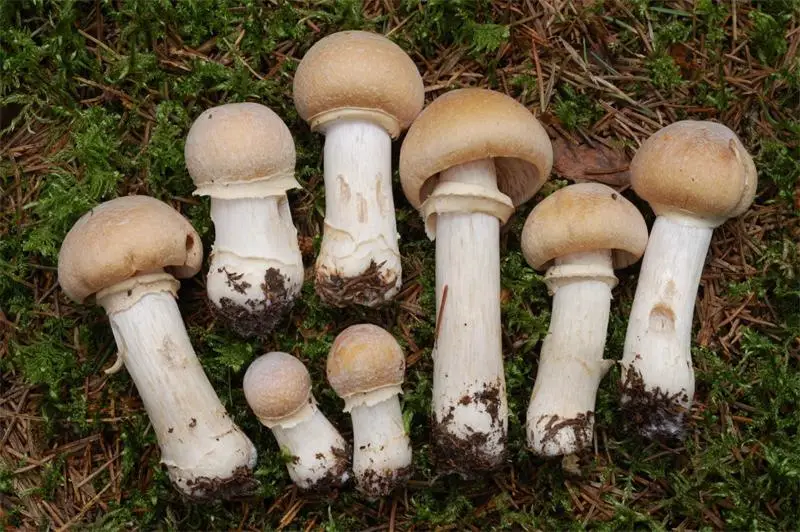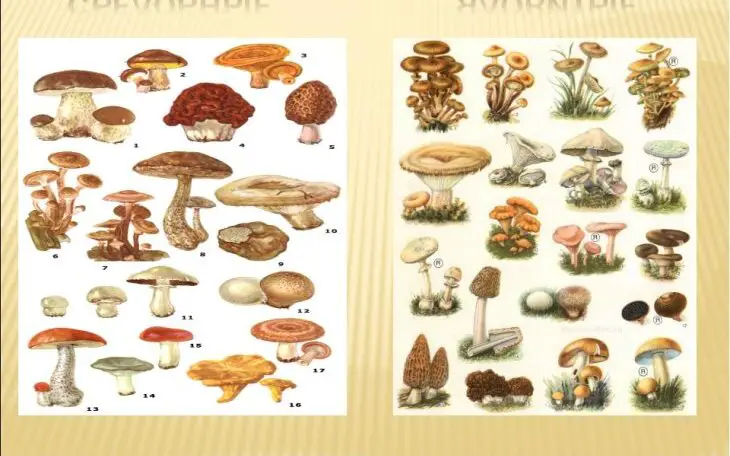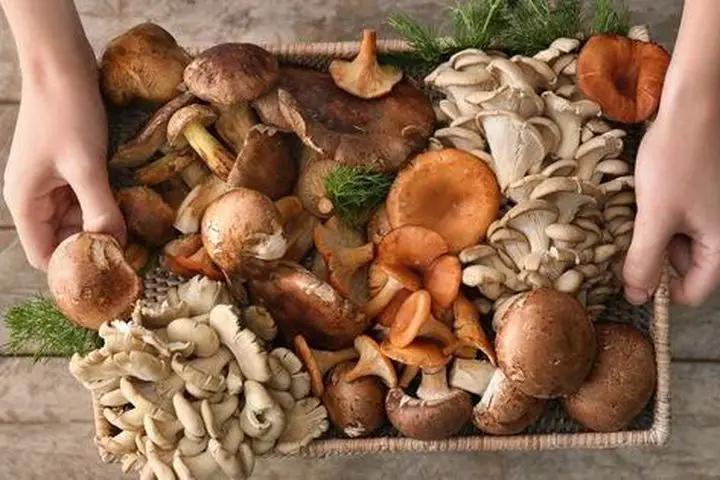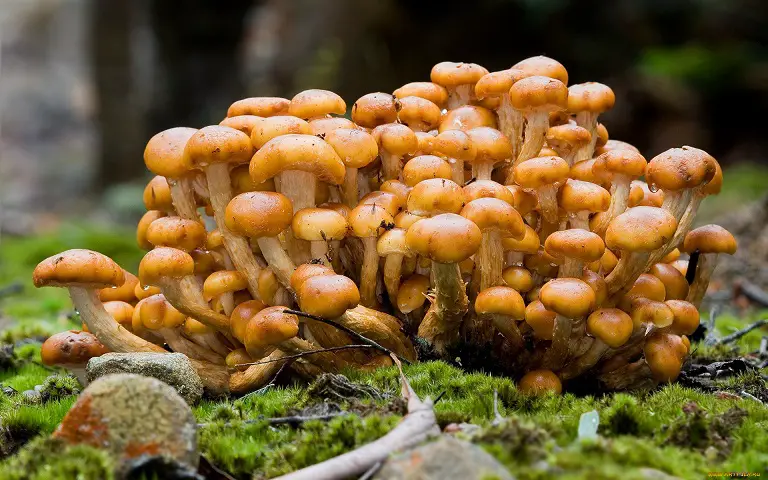Explore 100 mushrooms with their scientific and common names, habitats, and toxicity levels. Learn how to identify and stay safe with mushrooms.
Mushrooms are a diverse group of organisms that belong to the kingdom of Fungi. They come in a wide variety of shapes, sizes, and colors, and can be found in a variety of habitats all over the world.

Each mushroom species has a unique scientific name, which is used to identify and classify it within the scientific community. The scientific name is typically made up of two parts: the genus and the species. For example, the scientific name for the white button mushroom is Agaricus bisporus. The genus, Agaricus, is the group to which the mushroom belongs, and the species, bisporus, is the specific type of mushroom within that group.
Mushrooms also have common names, which are often used by non-scientists and vary depending on the region and culture. Common names can be less precise than scientific names, as different mushrooms may share the same common name.
For example, the scientific name Pleurotus ostreatus is commonly known as the oyster mushroom, but different species of mushrooms may also be referred to as oyster mushrooms.
Mushrooms can be found in a wide variety of habitats, including forests, grasslands, deserts, and even freshwater and marine environments. Some mushrooms grow on dead or dying trees, while others can be found growing on the ground, in leaf litter, or as symbionts with plants.
The habitat of a mushroom can vary depending on the species and the environmental conditions, such as temperature, humidity, and availability of nutrients. For example, some mushrooms like Agaricus campestris, commonly known as the meadow mushroom, are found in grassy fields, while others like the Chanterelle (Cantharellus cibarius) are found in broad-leaved and coniferous woods.
Here we have shared all the best Ways To Identify Mushrooms Accurately
Some species of mushrooms like the shiitake mushroom (Lentinula edodes) are cultivated for human consumption, while others like the deadly Galerina (Galerina marginata) are poisonous and should not be consumed.
The scientific names of mushrooms are a great method to differentiate and categorize different species of mushrooms, giving information about their identification and classification on them. Each species and genus name, for example Agaricus bisporus is the name given to the most commonly-used button mushroom [1].
Table of Contents
Understanding Mushroom Scientific Names & Taxonomy
Mushroom scientific names follow the binomial nomenclature system that utilizes species-genus classification of organisms. This form of nomenclature was pioneered by Swedish botanist Carl Linnaeus in 1753.
Fungal taxonomy involves classifying various fungi into hierarchical groups:
- Kingdom: Fungi
- Phylum
- Class
- Order
- Family
- Genus
- Species
To clarify, for instance, Agaricus bisporus, commonly seen in supermarkets, is its scientific name, in this instance Agaricus being its genus part and bisporus its species name.
do you want to discover Best Places To Find Morel Mushrooms.
Why Mushroom Scientific Names Matter?
Scientific names can be vitally important, for various reasons:
- Establishing a universal language: By adhering to a standard naming convention, scientists from different nations and languages can communicate effectively when discussing specific organisms.
- Accuracy and precision: Common names for mushrooms can often be misleading or lead to multiple species being discussed; scientific names provide a more precise indication of which species are being discussed, thus eliminating confusion. For instance, white button mushrooms are known in French as champignons while their Spanish equivalent is champinones.
- Documentation and Research: With new species identification reliant upon an universally acknowledged naming system, scientific names for mushrooms and fungi research is an integral component. Classes of Mushrooms: Edible, Medicinal and Poisonous
Categories of Mushrooms: Edible, Medicinal, and Poisonous

When exploring the world of mushrooms it can be useful to know that there are three categories of these fungi i.e, edible, medicinal, and poisonous:
- Edible mushrooms: Popular edible varieties include Agaricus bisporus (white button mushrooms), Pleurotus ostreatus (oyster mushrooms) and Lentinula edodes (shiitake mushrooms).
- Medicinal mushrooms: For centuries, various medicinal mushrooms such as Ganoderma lucidum (reishi) and Trametes versicolor (turkey tail) have been recognized for their potential therapeutic use.
- Poisonous mushrooms: Common poisonous species include Amanita muscaria (fly agaric) and Amanita phalloides (death cap), making it important to learn their scientific names to avoid accidental ingestion.
100 mushrooms scientific names, common names, habitat

Here is a list of some mushrooms and their corresponding scientific names, common names, and habitats.
This list includes a diverse range of mushroom species, each with unique characteristics, and is intended to give an overview of the variety of mushrooms that can be found in different environments.
It’s important to note that many mushrooms have different common names in different regions and cultures, and the habitat of a mushroom can also vary depending on location.
Mushroom taxonomy is based on an organized hierarchy which encompasses kingdom classification, phylum, class family, order Genus, species and genus[2].
This list is not exhaustive, and new species of mushrooms are continually being discovered and studied.
| Scientific Name | Common Name | Habitat Description | Toxicity | Additional Information |
|---|---|---|---|---|
| Agaricus bisporus | White Button Mushroom | Cultivated beds, gardens, lawns, and pastures. | Edible | Cultivated for culinary use. |
| Pleurotus ostreatus | Oyster Mushroom | Dead or dying hardwood trees, such as oak and poplar. | Edible | Commonly used in cooking. |
| Lentinula edodes | Shiitake Mushroom | Dead or dying hardwood trees, such as oak and maple. | Edible | Popular edible mushroom. |
| Agaricus campestris | Meadow Mushroom | Grassy fields and meadows. | Edible | Found in grassy areas. |
| Cantharellus cibarius | Chanterelle | Coniferous and deciduous forests. | Edible | Cherished by foragers. |
| Boletus edulis | Porcini or Cep Mushroom | Coniferous and deciduous forests. | Edible | Highly regarded in cuisine. |
| Clitocybe nebularis | Clouded Agaric | Coniferous and deciduous forests. | Edible | Found in woodland areas. |
| Clitocybe odora | Aniseed Toadstool | Broad-leaved and coniferous woods. | Toxic | Has an anise-like odor. |
| Coprinus comatus | Shaggy Ink Cap | Grassy fields, meadows, and lawns. | Edible | Cap dissolves into ink-like liquid. |
| Craterellus cornucopioides | Trumpet Chanterelle | Broad-leaved and coniferous woods. | Edible | Resembles a trumpet shape. |
| Entoloma lividum | Livid Pinkgill | Heaths, acid grassland, and woods. | Toxic | Features a pinkish gill. |
| Fomes fomentarius | Tinder Fungus | Dead or dying hardwood trees, such as birch and beech. | Inedible | Used historically for fire starting. |
| Galerina marginata | Deadly Galerina | Dead or dying hardwood trees, such as birch and beech. | Poisonous | Contains toxic substances. |
| Ganoderma lucidum | Reishi Mushroom | Dead or dying hardwood trees, such as maple and oak. | Medicinal | Used in traditional medicine. |
| Gomphus floccosus | Scaly Chanterelle | Broad-leaved and coniferous woods. | Edible | Known for its scaly cap. |
| Hydnum repandum | Hedgehog Mushroom | Broad-leaved and coniferous woods. | Edible | Spines beneath the cap. |
| Lepiota cristata | Stinking Dapperling | Lawns, grassy fields, meadows, and woods. | Toxic | Has a foul odor. |
| Leccinum scabrum | Brown Birch Bolete | Under birch trees. | Edible | Often found in birch forests. |
| Leccinum aurantiacum | Orange Birch Bolete | Under birch trees. | Edible | Typically found in birch forests. |
| Macrolepiota procera | Parasol Mushroom | Grassy fields and meadows. | Edible | Recognizable by its large cap. |
| Mycena galericulata | Common Bonnet | Broad-leaved and coniferous woods. | Edible | Named for its bonnet-like cap. |
| Mycena pura | Lilac Bonnet | Broad-leaved and coniferous woods. | Edible | Recognizable by its lilac hue. |
| Amanita pantherina | Panther Amanita | Coniferous and deciduous forests. | Toxic | Contains toxic substances. |
| Amanita rubescens | Blusher | Coniferous and deciduous forests. | Edible | Cap often turns pink with age. |
| Armillaria ostoyae | Western Oak Armillaria | Dead or dying hardwood trees, such as oak. | Parasitic | Parasitic on hardwood trees. |
| Clitopilus prunulus | Miller | Meadows, pastures, and roadsides. | Edible | Cap resembles a miller’s hat. |
| Clitocybe clavipes | Club Foot | Broad-leaved and coniferous woods. | Toxic | Known for its club-shaped base. |
| Coprinopsis atramentaria | Common Inkcap | Lawns, grassy fields, meadows, and woods. | Edible | Cap turns into inky liquid. |
| Craterellus tubaeformis | Yellowfoot Chanterelle | Broad-leaved and coniferous woods. | Edible | Named for its yellow foot. |
| Entoloma sinuatum | Blueing Entoloma | Lawns, grassy fields, meadows, and woods. | Toxic | May turn blue when bruised. |
| Fomitopsis pinicola | Red-Belted Polypore | Dead or dying coniferous trees, such as pine and spruce. | Medicinal | Has medicinal properties. |
| Ganoderma applanatum | Artist’s Conk | Dead or dying hardwood trees, such as maple and oak. | Medicinal | Used for artistic purposes. |
| Gomphus kauffmanii | Matsutake | Coniferous forests. | Edible | Highly valued in Japanese cuisine. |
| Hydnum rufescens | Red Hedgehog | Broad-leaved and coniferous woods. | Edible | Features spines on the cap. |
| Hygrophorus eburneus | Ivory Woodwax | Broad-leaved and coniferous woods. | Edible | Cap has a waxy appearance. |
| Mycena lilacina | Lilac Fibrecap | Broad-leaved and coniferous woods. | Edible | Recognizable by its lilac color. |
| Lactarius blennius | Dappled Milkcap | Broad-leaved and coniferous woods. | Edible | Cap often features dappled patterns. |
| Lepiota naucina | Brown Dapperling | Lawns, grassy fields, meadows, and woods. | Toxic | May have a brownish cap. |
| Leccinum aurantiacum var. aurantiacum | White Birch Bolete | Under birch trees. | Edible | Typically found in birch forests. |
| Leccinum scabrum var. rugosiceps | Birch Bolete | Under birch trees. | Edible | Often found in birch forests. |
| Macrolepiota procera var. | Grassy fields and meadows. | Edible | Recognizable by its large cap. | |
| Tubaria furfuracea | Tawny Funnel | Broad-leaved and coniferous woods. | Edible | Features a tawny-colored cap. |
| Xerocomus badius | Bay Bolete | Broad-leaved and coniferous woods. | Edible | Known for its brownish cap. |
| Xerocomus boletus | Porcini | Broad-leaved and coniferous woods. | Edible | Highly prized in culinary use. |
| Xerocomus chrysenteron | Red Cracking Bolete | Broad-leaved and coniferous woods. | Edible | Cap may develop cracks. |
| Xerocomus subtomentosus | Velvet Bolete | Broad-leaved and coniferous woods. | Edible | Recognizable by its velvety cap. |
| Xylaria hypoxylon | Candlesnuff Fungus | Dead or dying hardwood trees, such as oak and poplar. | Inedible | Resembles burnt candle wicks. |
| Xylaria polymorpha | Dead Man’s Fingers | Dead or dying hardwood trees, such as oak and poplar. | Inedible | Resembles skeletal fingers. |
| Pleurotus cornucopiae | Horn of Plenty | Dead or dying hardwood trees, such as oak and poplar. | Edible | Named for its horn-like shape. |
| Leccinum aurantiacum var. aurantiacum | Orange Birch Bolete | Under birch trees. | Edible | Typically found in birch forests. |
| Cantharellus cibarius var. roseocanus | Rosy Chanterelle | Coniferous and deciduous forests. | Edible | Features a rosy hue. |
| Morchella esculenta var. esculenta | Morel Mushroom | Deciduous forests, particularly under elm and ash trees. | Edible | Highly sought after in cuisine. |
How to Use Mushroom Scientific Names?

As a beginner in mushroom identification, you may find yourself wondering how to utilize scientific names as you explore this fascinating world. Here are a few strategies for applying your newly gained knowledge:
- Mushroom foraging: Knowing which species are edible or toxic is paramount to safe, responsible mushroom foraging. Learning scientific names for mushrooms you find will ensure accurate identification.
- Cooking and medicinal use: Knowing the scientific names of mushrooms you add to your diet or use as medicine will ensure there are no misinterpretations of which species is being utilized.
- Appreciating Biodiversity: Familiarizing yourself with mushroom scientific names allows you to recognize the vast array of fungi present in nature, deepening your connection to mother earth. Tips for Learning Mushroom Scientific Names
Tips for Learning Mushroom Scientific Names
Here are a few tips to help you learn and remember the scientific names of mushrooms:
- Use field guides, books and expert resources that use scientific names.
- Additionally, keep an eye out for new revisions or updates so as to stay well-informed of potential name changes due to taxonomic classification updates; ; keeping abreast of updates keeps you well-informed of developments in science.
- Join local mycological clubs or societies offering educational resources and welcoming beginners.
- Exploring mobile mushroom identification apps can assist with learning scientific names.
Safety tips
Here are some safety Tips on some of the mushrooms on the table:
- Amanita pantherina as well as Amanita rubescens both belong to the same part of the Genus Amanita that includes a variety of poisonous mushrooms. It is crucial to know how to distinguish these two species since they may be confused. Amanita pantherina is poisonous however, Amanita rubescens can be eaten.
- Armillaria ostoyae, also known as the “silver fungus,” is fungus that parasitizes and could kill trees. It is crucial that you are aware of the fungus particularly if you live in an region where oak trees are prevalent.
- Fomes fomentarius as well as Ganoderma Lucidum are both medicinal mushrooms. Fomes fomentarius was traditionally used to start fires and igniting, whereas Ganoderma lucidum was used in traditional medicine for many centuries.
- Gomphus kauffmanii is an edible mushroom that is highly sought-after in Japanese food preparation. It is famous for its savory, smoky flavor.
- Xerocomus badius is an edible mushroom, which is typically located in forests of conifers. It is covered in a brownish cap, and an uncolored stem.
- Xerocomus boletus is an additional common edible mushroom which is usually located in forests of coniferous trees. It is famous for its dimensions and delicious flavor.
Conclusion
Mushrooms have unique scientific names that are used to classify and identify them within the scientific community. They also have common names, which can vary depending on the region and culture. The habitat of mushrooms can vary greatly, depending on the species and environmental conditions.
Identification of mushrooms is fun, but it is vital to ensure that participants take the proper safety precautions while eating mushrooms[3].
The edible mushrooms are appreciated for their nutritional as well as culinary reasons. There are many recipes that can turn poisonous ones into edible ones[4].
Citations:
[1] https://www.mssf.org/cookbook/names.html
[2] https://www.mushroomexpert.com/taxonomy.html
[3] https://www.mushroom-appreciation.com/mushroom-identification.html
[4] https://en.wikipedia.org/wiki/Edible_mushroom